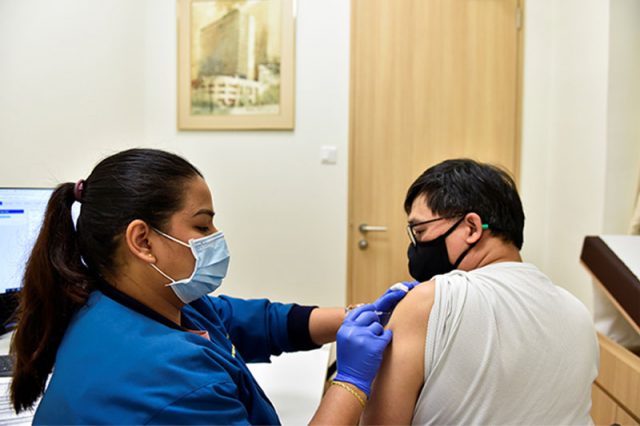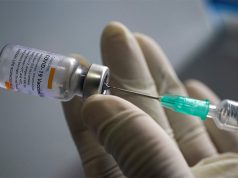
By now more than 70% of the UK population have received a third COVID vaccination, or a booster. Many people who are older or at higher risk from COVID have had a fourth or even a fifth dose. But for how long and how often can we expect to continue to get COVID boosters? An annual booster, as we have with flu, could be a worthwhile precaution moving forward.
COVID vaccines have played a crucial role in protecting people against serious illness, hospitalization and death from infection with SARS-CoV-2, the virus that causes COVID-19. However, vaccine immunity, particularly against infection, begins to wane after a few months.
Fortunately, booster vaccines effectively top up our immunity against SARS-CoV-2. As with the initial doses, the protection boosters afford against serious outcomes is longer-lasting than against infection. But this too is finite.
By four months after a third dose of an mRNA vaccine, protection against omicron begins to wane. One study showed that after a fourth dose, protection against infection peaked at four weeks, and then began to decline gradually thereafter.
Recent data has shown an increase in COVID infections in England and Wales, which is likely in part because vaccine immunity is beginning to wane for many people who had their third dose some months ago.
Who should have a booster and when?
Throughout the pandemic we’ve seen that older people and those with certain underlying health issues, among others, are at increased risk of serious illness, hospitalization and death from COVID.
So should we just give boosters to the most vulnerable every four months or so to help counteract the gradual decline in immunity? Or might a longer interval between doses be just as effective?
Officials in the US recently suggested that, looking ahead, most Americans are likely to receive a single annual COVID shot. While immunity against infection may wane earlier in the year, this could be a practical compromise to ensure as many as possible are protected against serious illness and hospitalization ahead of the winter.
But the incidence of serious illness and death in young people has been much less, so do they really need annual boosters too? A Swiss modelling study concluded that boosting only the most vulnerable groups isn’t likely to alleviate the impact of COVID on health systems. In part, this is because COVID vaccination doesn’t only protect the person being vaccinated, but indirectly protects others as well by reducing onward spread of the disease.
The authors propose that, while prioritizing the most vulnerable, boosting most of the population each year three to four months ahead of the winter peak is likely to be the best way to reduce infections and hospital admissions.
What vaccines should we use?
Until recently most of the approved COVID vaccines have targeted the spike protein on the surface of the original strain of SARS-CoV-2. But some variants have mutations in their spike proteins that help them to evade the immunity gained from previous infection or vaccination.
To counteract this, updated COVID vaccines that include the spike protein from the omicron variant are now being administered in some countries around the world, including to vulnerable groups in the UK. These “bivalent” vaccines are designed to offer a broader level of protection against COVID variants than that provided by the original vaccines.
But future variants might contain mutations that enable the virus to dodge the immunity even from these updated vaccines. And predicting which variant comes next is very difficult.
Given this, scientists are looking at different vaccine formats to future-proof COVID vaccines against a wider range of variants, avoiding the need for regular updates.
One candidate comprises nanoparticles that contain fragments of spike proteins from SARS-CoV-2 and seven other closely related viruses. In animal studies this vaccine provided good protection against infection with different coronaviruses.
Vaccines that train our T cells to recognize components of the SARS-CoV-2 virus other than the spike protein might also offer wider protection against future variants.
Meanwhile, since SARS-CoV-2 infects the respiratory tract, administering the vaccine via a drop or spray to the mouth or nose could help train the mucosal immune system that lines the respiratory tract to recognize and kill the virus at its point of entry.
Many mucosal vaccines are in development and two are approved for use in China and India. Animal studies suggest this approach has the potential to block infection, achieving what’s called sterilizing immunity. However, these studies are preprints, meaning they’re yet to be peer-reviewed. And we’ll need to see the results replicated in humans too.
An annual shot
COVID vaccines remain the most effective and safest way to protect against serious illness and death from the virus.
Reports on social media have suggested that repeated vaccination burns out your immune system, but this is not true. Annual flu shots have been offered for decades with no evidence that this negatively affects immunity.
For some in the highest-risk groups, a more frequent booster may be required. But an annual COVID shot for most people seems a sensible way forward. Timed as winter approaches, this will help protect the most vulnerable from serious illness and death, and reduce the strain this disease has on our health systems.![]()
Neil Mabbott, Personal Chair of Immunopathology, The University of Edinburgh. This article is republished from The Conversation under a Creative Commons license. Read the original article.









